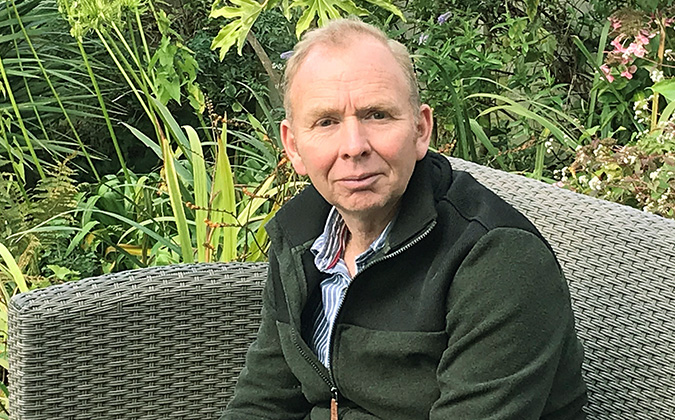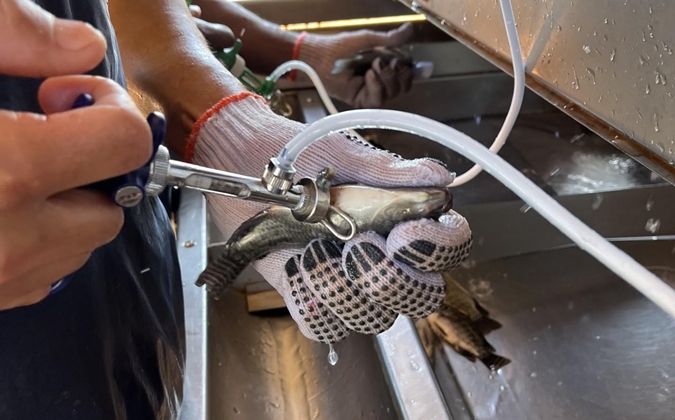
Understanding how diseases arise and spread can guide global aquaculture’s responses
An interview with Edmund Peeler, PhD, principal epidemiologist at the Centre for Environment, Fisheries and Aquaculture Science (Cefas).
Q: Your team’s focus is all about predicting and managing health risks in aquaculture. Can you explain how that works in practice and highlight some of the major projects you’ve been involved with?
EP: One of the first projects I was involved in at Cefas was assessing the risk of the reintroduction of the parasite Gyrodactylus salaris, which we don’t have in the UK but caused high mortality among wild salmon in Norway. We looked at pathways for the pathogen entering the country and checked the adequacy of mitigation measures and contingency planning. Since then, we have done a lot of similar work looking at exotic pathogens, particularly viruses — for example, working out what threat the import of rainbow trout carcasses posed.
The team has also looked at mathematical modeling of disease spread. Those models have been used to determine the resources that we need in place and to help answer “what if” questions, such as the importance of time to first detection, and how the outbreak might unfold if you had different policies in place around fallowing after farms have been de-stocked, and the risks of allowing farmers to grow stock until harvest weights.
These models could be used in the event of an outbreak to see how policies in real time might impact the course of the disease. We’ve also started using them to look at the economic consequences of disease outbreaks on different sections of the industry.
Q: On the economic side, you have been doing some work looking at fish-health interventions, involving the World Bank. Tell us more about that.
EP: We were looking at pangasius in Vietnam, shrimp in Sri Lanka and rainbow trout in Peru, working with collaborators in each of those countries. We developed a bio-economic model for a typical farm in each of those systems, and we then were able to run that model to generate gross margins for production using data from existing literature and some expert opinion.
Then we used the model to do a series of analyses, looking to see essentially what the breakeven points are using various interventions: vaccination against Edwardsiella and Aeromonas in pangasius, vaccination against infectious pancreatic necrosis in rainbow trout, and a prebiotic in shrimp. We wanted to know to what extent mortality needs to be reduced to generate increased production that will match the costs of these measures.
We brought in colleagues from Liverpool who work on the Global Burden of Animal Diseases program and applied some of their methods to assess the total economic cost of disease in these systems.
We’re publishing a paper shortly on the analyses of rainbow trout and shrimp systems, which shows, albeit from the limited data available, that there is highly likely to be a positive return on investment from vaccination and probiotics. With pangasius, the initial results also suggest a high burden of disease and similarly positive returns, but we would like to do further analysis using field data.
Q: When building these kinds of models, do you feel that there are adequate data available from the aquaculture industry to ensure the right level of predictive power?
EP: Some of the data from industry, such as on growth, feed conversion and mortality, is considered commercially sensitive. However, in some markets, like in the UK, producers are obliged to report mortality to the government, and that is made available at aggregate level.
I think the bigger issue is particularly in low- and middle-income countries in tropical, small-scale aquaculture, where there’s a real dearth of information on which to really assess the economic impact of disease, the rate of disease spread and even the prevalence of many of these diseases. When governments need to make decisions around investments in animal health, we’re constantly having to resort to expert opinion to plug those gaps. Implementing more systematic approaches to collecting data is really important in the long term.
Q: How can this problem be overcome?
EP: There’s clearly a role for government, similar to how in Europe and other developed economies farms are authorized, and as a condition for authorization, farmers are obliged to keep records around mortality, medicine use and fish movements. We’re also doing quite a lot of work moving to online data recording, providing incentives for farmers to record information online, and making quite a lot of progress there. The great advantage then is that you get the data in real time rather than periodically.
In terms of working in lower- and middle-income countries where you don’t have such a well-developed regulatory system or well-funded government departments, I think the solutions must be based around farmer-centric surveillance systems. There must be benefits to the farmers which incentivize them to report disease, with a bottom-up approach where you start with the needs of the farmers rather than the needs of the government. There are some good examples on the terrestrial livestock side, where those systems have been successful in generating data.
Q: Where are the biggest remaining knowledge gaps in preventing the spread of disease within and among fish-farming facilities?
EP: In the developed nations involved in aquaculture, I don’t think there are too many glaring gaps. Producers like those in the rainbow trout industry in the UK, which we’re very involved with, generally are aware of the disease threats, they’ve got good monitoring systems, they know what levels of mortality are there, and they know what biosecurity measures they need to put in place to protect themselves against the introduction of diseases.
I think the more glaring gaps can be found in small-scale freshwater aquaculture production in Africa or Asia, where many people are relatively new to fish farming, and there’s often a lack of the basics around biosecurity and how to protect fish from disease. There’s also more inherent risk for newer industries, partly because they’re bringing in stock from elsewhere but also the risk of emergence of diseases from wild-animal populations within the country. Those risks often only become apparent once you’ve started farming in those countries, and you’ve got farm stocks in which those diseases can emerge.
Q: What are the things that governments, NGOs and the industry could be doing differently?
EP: I think biosecurity and aquatic-animal health is a shared responsibility between industry and government. There are some key elements that only government can fulfil, such as border security, farm authorizations and listing in legislation and control of important diseases. Governments need to develop their own capacity and their own regulation, in parallel with the developing industry. Where problems have arisen in the past is growth in aquaculture has outpaced government’s ability to develop necessary legislation, and capacity, for example in disease control.
There are also lots of cases of international spread of diseases, impacting both wild and farmed populations, so international cooperation and sharing of information globally through the World Organisation of Animal Health (WOAH) is critical to reducing risk at the global level. There’s certainly more work to be done in that space, as despite WOAH’s best efforts, the sharing and cooperation is not at the level that we really need it to be at.
Posted on: October 25, 2023







